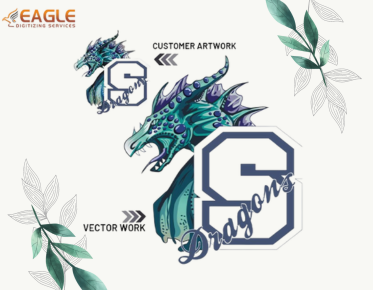Vector Digitizing’s Role in Medical and Scientific Visualization
In the realms of science and medicine, where precision is paramount, the ability to visualize complex data and concepts is indispensable. The advent of advanced technology has revolutionized how we approach these visualizations, making them more accurate, detailed, and accessible. One of the most significant advancements in this area is vector digitizing, a technique that plays a crucial role in transforming intricate scientific and medical data into clear, scalable visuals. This fusion of technology and visualization not only aids in understanding but also enhances communication across various fields, from research to patient care. If this post spurred your interest and you want to find out more about online vector conversion, please feel free to contact us.
Vector Digitizing in Medical Imaging
Converting Complex Data into Clear Visuals
Medical imaging generates vast amounts of data, often in forms that are difficult to interpret without specialized tools. Vector digitizing helps convert this complex data into clear, understandable visuals. By tracing over medical images such as X-rays, MRIs, and CT scans, vector digitizing creates simplified, yet accurate, representations that medical professionals and patients alike can easily interpret.
Enhancing Diagnostic Imaging: X-rays, MRIs, and CT Scans
Diagnostic imaging is a cornerstone of modern medicine, and vector digitizing plays a crucial role in enhancing these images. By converting X-rays, MRIs, and CT scans into vector graphics, medical professionals can highlight specific areas of interest, enhance contrast, and remove extraneous details. This not only improves the clarity of the images but also aids in more accurate diagnoses and treatment planning.
The Role in 3D Modeling and Surgical Planning
In the context of 3D modeling and surgical planning, vector digitizing is indispensable. It allows for the creation of detailed, accurate 3D models based on medical imaging data. These models can be used to plan complex surgeries, providing surgeons with a precise visual representation of the patient’s anatomy. This level of detail and accuracy is crucial for minimizing risks and improving patient outcomes.
Vector Graphics in Patient Education: Simplifying Complex Concepts
Patient education is an essential aspect of healthcare, and vector graphics can play a significant role in this process. By simplifying complex medical concepts into clear, easy-to-understand visuals, vector digitizing helps bridge the gap between medical professionals and patients. Whether it’s explaining a surgical procedure, illustrating the effects of a condition, or showing how a treatment works, vector graphics make it easier for patients to understand and engage with their healthcare.
Scientific Illustrations: The Impact of Vector Digitizing
From Hand-Drawn Sketches to Digital Masterpieces
Scientific illustrations have come a long way from the days of hand-drawn sketches. Today, vector digitizing allows for the creation of digital masterpieces that are not only beautiful but also highly accurate and detailed. By converting hand-drawn illustrations into vector graphics, artists and scientists can preserve the artistic quality of their work while adding the precision and scalability that digital technology provides.
Creating Detailed and Accurate Scientific Diagrams
Scientific diagrams are essential tools for conveying complex information, and vector digitizing ensures that these diagrams are both detailed and accurate. Whether it’s a cellular structure, a chemical process, or an ecological system, vector graphics allow for the precise representation of scientific concepts. This precision is crucial for ensuring that the diagrams are informative and that they accurately convey the intended message.
Vector Graphics in Research Papers and Publications
In academic and research contexts, the quality of visuals can significantly impact the effectiveness of a paper or publication. Vector digitizing ensures that the graphics used in research papers are of the highest quality, with sharp lines, clear details, and accurate representations. This not only enhances the visual appeal of the publication but also improves the clarity and accessibility of the information being presented.
Applications of Vector Digitizing in Anatomy Visualization
Detailed Anatomical Charts and Diagrams
Anatomical charts and diagrams are foundational tools in medical education and practice. Vector digitizing allows for the creation of highly detailed and accurate anatomical visuals that are both informative and easy to interpret. These visuals are essential for teaching, diagnosis, and treatment, providing a clear representation of the human body’s structure and functions.
Interactive Models for Medical Education
In medical education, interactive models are increasingly being used to enhance learning. Vector digitizing enables the creation of these models, providing a dynamic, interactive experience that helps students understand complex anatomical structures and functions. These models can be manipulated, explored, and studied in detail, offering a more engaging and effective learning experience.
Vectorizing Histological Samples: Seeing the Microscopic World
Histology, the study of tissues at the microscopic level, requires detailed and accurate visualization. Vector digitizing allows for the conversion of histological samples into clear, scalable graphics that can be studied in detail. These visuals are crucial for understanding the structure and function of tissues, aiding in research, diagnosis, and education.
3D Anatomical Models: Precision in Teaching and Research
3D anatomical models are invaluable tools in both teaching and research, providing a detailed, accurate representation of the human body. Vector digitizing plays a crucial role in creating these models, ensuring that they are both precise and scalable. Whether used in the classroom or the lab, these models provide a deeper understanding of anatomy, enhancing both education and research.
Vector Digitizing in Pharmaceutical Visualization
Drug Mechanisms of Action: Clear and Concise Representations
Understanding how drugs work is essential for both healthcare professionals and patients. Vector digitizing allows for the creation of clear and concise visual representations of drug mechanisms of action, making it easier to understand how a drug interacts with the body. These visuals can be used in everything from research papers to patient education materials, providing a clear explanation of complex processes.
Vectorizing Molecular Structures for Better Understanding
Molecular structures are often complex and difficult to visualize. Vector digitizing simplifies these structures, creating clear, accurate representations that are easy to understand. These visuals are crucial for studying and communicating the intricacies of molecular biology, aiding in research, education, and drug development.
Visualizing Drug Interactions and Pathways
Drug interactions and pathways are critical components of pharmacology, and visualizing these processes is essential for understanding how different drugs work together in the body. Vector digitizing allows for the creation of detailed, accurate visuals that illustrate these interactions, providing a clear understanding of complex pharmacological processes.
Patient Information Leaflets: Simplifying Drug Information
Patient information leaflets are an important tool for communicating drug information to patients. Vector digitizing helps simplify and clarify this information, creating clear, easy-to-understand visuals that help patients understand how to use their medications safely and effectively. These visuals are crucial for improving patient compliance and outcomes.
The Role of Vector Digitizing in Genetic Research
Visualizing DNA Sequences and Genetic Pathways
Genetic research involves complex data that is often difficult to interpret without visual aids. Vector digitizing enables the creation of clear and detailed visualizations of DNA sequences and genetic pathways. These graphics help researchers understand genetic structures and relationships, facilitating the study of gene functions, mutations, and interactions. By turning intricate data into comprehensible visuals, vector digitizing supports advancements in genetics and genomics.
Creating Clear and Accurate Chromosome Maps
Chromosome maps are essential for studying genetic variations and disorders. Vector digitizing allows for the creation of accurate and detailed chromosome maps that display genetic information with clarity. These maps are crucial for research into genetic diseases, chromosome abnormalities, and genetic engineering. The precision of vector graphics ensures that these maps are both informative and reliable.
Vector Graphics in Genetic Engineering: Illustrating Complex Processes
Genetic engineering involves manipulating genetic material to achieve specific outcomes. Vector digitizing helps illustrate these complex processes by providing clear, detailed graphics that depict genetic modifications, gene transfers, and the effects of genetic alterations. These visuals are valuable for understanding and communicating the intricacies of genetic engineering, both in research and in educational contexts. For the top-notch vector art services, don't hesitate to get in touch with us.
Educational Tools for Genetics: Simplifying the Science
Educational tools that use vector graphics can make complex genetic concepts more accessible to students and the general public. By simplifying intricate genetic data into clear, visually engaging graphics, vector digitizing helps facilitate learning and understanding. These tools are used in textbooks, online courses, and educational presentations to convey genetic principles and discoveries in a way that is easy to grasp.
Challenges in Vector Digitizing for Medical and Scientific Use
The Complexity of Data: Turning Raw Data into Clear Visuals
One of the main challenges in vector digitizing is converting complex raw data into clear, comprehensible visuals. This process requires careful consideration of how to represent intricate details without overwhelming the viewer. Ensuring that the final visuals are both accurate and easily interpretable is crucial for effective communication and understanding.
Balancing Detail with Simplicity: Avoiding Information Overload
Striking the right balance between detail and simplicity is essential in vector digitizing. While it’s important to include all relevant information, too much detail can lead to information overload. Finding the right level of detail that conveys the necessary information without confusion is a key challenge in creating effective visuals.
Ensuring Accuracy: The Importance of Quality Control
Accuracy is paramount in medical and scientific visualization. Ensuring that vector graphics accurately represent the data or concepts is essential for maintaining credibility and effectiveness. Quality control measures, such as rigorous review processes and validation checks, are crucial for ensuring the precision and reliability of the visuals.
Technical Limitations and Software Constraints
Technical limitations and software constraints can pose challenges in vector digitizing. Issues such as software bugs, compatibility problems, and limitations in processing power can impact the quality and efficiency of the digitizing process. Staying up-to-date with the latest software developments and addressing technical challenges proactively is important for overcoming these constraints.
Vector digitizing has become an essential tool in modern science and medicine, transforming complex data and concepts into clear, scalable, and accurate visuals. Its applications range from enhancing medical imaging and scientific illustrations to supporting pharmaceutical visualization and environmental studies. As technology continues to advance, the role of vector digitizing will only grow, driving innovation and improving communication across various fields. By understanding and leveraging the power of vector graphics, professionals can create visuals that not only convey information effectively but also contribute to advancements in research, education, and patient care.



